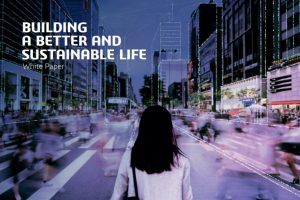The following article is excerpted from Building a Better and Sustainable Life, a whitepaper developed by Dassault Systèmes. For part 1 of this series, read here.
Boosting trust between all stakeholders and citizens
Data is a key equation in building sustainable, inclusive, smart cities. But without trust in data and trust between the stakeholders involved in urban development, nothing substantive will happen.
Today, virtual twin technology and the 3DEXPERIENCE platform make it possible for cities and their service providers to improve communications and services, to think eco-system rather separate entities – cities, states and territories now have at their fingertips powerful tools to identify and simulate issues earlier, faster and more cost-effectively. Subsequently, they can plan and adjust the right responses to meet and even exceed citizen expectations.
“Today cities tend to think in silos. But that’s not how a city works. What we need today is a more systemic approach for all stakeholders to collaborate around a common referential to simulate the evolution of the city. We have partnered with Dassault Systèmes to help us set up a platform on the cloud, called 3DEXPERIENCity Virtual Rennes. With it, all city stakeholders can remotely share and observe data that simulates urban phenomena.”
– Alexis Mariani, Director Urban Planning and Housing, City of Rennes
For example, in Singapore, 30% of the population suffered from diabetes so the government wanted to promote active mobility including cycling and walking.
This involved creating new cycling paths. Although only 1 in 6 inhabitants have cars, the city was designed for cars and rethinking this is not simple as it involves both land owned by the city but also private land. This impacted how negotiations were managed.
With virtual twin technology and the 3DEXPERIENCE platform, Dassault Systèmes and Singapore were able to do four things:
- Simulate the different options for more accurate planning
- Integrate all obstacles to cycling paths (example, no cycling paths by retirement homes, protection of pedestrians, and cohabitation with other traffic…)
- Identify land property and buy-back scheme
- Help produce new generation 3D communications tools to drive citizen engagement around the city projects
Singapore is not alone – many large cities want to reduce the number of cars and are promoting walking and cycling to drive better health outcomes. It is not a new trend but a long term one that COVID-19 has accelerated.

Be citizen-centric & involve the community earlier
Today, the conversation between city officials and their ecosystem is a two-way street. With 3D modeling and other digital technology now available, Cities can take the pulse of the ecosystem on a wide range of issues such as green spaces, energy efficiency, transport & mobility, health, security. They then use the feedback to understand key concerns and integrate continuous improvements to the system that they can then communicate back in a kind of virtuous circle. This drives more robust civic engagement and secures stronger buy-in to short and long-term projects.
Currently, Rennes Métropole is working on their Bento project, which aims to develop a building-wide energy map based on demographic, land and energy data. The data needs to be accessible to internal and external stakeholders of the city. Through 3DEXPERIENCity, data developed at different scales can be integrated into a collaborative platform, fostering the development of effective public policies.
- If we look at buildings, they account for 50% of City gas
- A key issue is that private owners only see a return on investments from changing windows or insulating walls or controlling temperatures after a few years. So people delay making the investments and this becomes a major issue at city
- Planning how to incentivize citizens to undertake the upgrades whilst controlling costs is critical for cities. They need to know where to focus their investments to maximize impact on the City’s environmental
- Dassault Systèmes works with a partner who analyzes scenarios at a granular level, and then all data is aggregated on the 3DEXPERIENCE platform.
Defining better policies
Citizen trust in global leadership is at an all-time low. But this provides opportunities for cities and local governments to step up and fill the void. This is happening across the world on health, climate change and environmental issues. Science and technology have a big role to play as enablers, providing there is determined leadership, effective policy making, and meaningful collaboration across City ecosystems.

Sustainable urban development has entered a new era, impacted by demographic & regulatory pressures, climate change and a new scale of difficult-to-predict short and long-term challenges.
Related links:
Dassault Systèmes Construction, Cities & Territories Industry
